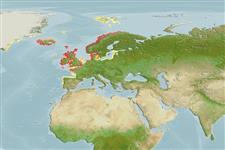Common names from other countries
>
Eupercaria/misc (Various families in series Eupercaria) >
Labridae (Wrasses)
Etymology: Centrolabrus: Greek, kentron = sting + Greek, labros = furious (Ref. 45335).
More on author: Linnaeus.
Environment: milieu / climate zone / depth range / distribution range
Ecología
marino asociado a arrecife; rango de profundidad 3 - 10 m (Ref. 130218). Temperate; 80°N - 33°N, 47°W - 25°E
Eastern Atlantic: Norway to Portugal; also eastern Greenland.
Tamaño / Peso / Age
Maturity: Lm ? range ? - ? cm
Max length : 18.0 cm TL macho / no sexado; (Ref. 4645); common length : 12.0 cm TL macho / no sexado; (Ref. 3397); edad máxima reportada: 6 años (Ref. 4792)
Espinas dorsales (total) : 18 - 20; Radios blandos dorsales (total) : 5 - 7; Espinas anales: 4 - 6; Radios blandos anales: 6 - 8. Snout with 5-10 pores. Upper lip with 5-7 folds. Rows of scales on cheek 3-5, on inter-operculum 2 (7-11) scales, on temporo-occipital surface 5-8. Vertebrae 32-34. Preoperculum edge serrated. One row of scales on base of soft part of dorsal and anal fins (Ref. 232). No black spots on the body or fins (Ref. 35388).
Adults are found in eel-grass beds near rocks. Feed on small invertebrates (Ref. 4742). Eggs are laid in the summer in a seaweed nest (Ref. 35388). Males grow faster than females (Ref. 4792). Oviparous, distinct pairing during breeding (Ref. 205). Used in salmon culture as cleaner fish (Helmut Tethmeyer, pers. comm.).
Life cycle and mating behavior
Maturities | Reproducción | Spawnings | Egg(s) | Fecundities | Larva
Oviparous, distinct pairing during breeding (Ref. 205). Males build dish shaped nests and guard the eggs (Ref. 205). Also Ref. 103751.
Quignard, J.-P. and A. Pras, 1986. Labridae. p. 919-942. In P.J.P. Whitehead, M.-L. Bauchot, J.-C. Hureau, J. Nielsen and E. Tortonese (eds.) Fishes of the north-eastern Atlantic and the Mediterranean. UNESCO, Paris. Vol. 2. (Ref. 4742)
IUCN Red List Status (Ref. 130435)
CITES (Ref. 128078)
Not Evaluated
Threat to humans
Harmless
Human uses
Pesquerías: sin interés; Acuario: Acuarios públicos
Herramientas
Special reports
Download XML
Fuentes de Internet
Estimates based on models
Preferred temperature (Ref.
115969): 8.9 - 13, mean 10.7 (based on 352 cells).
Phylogenetic diversity index (Ref.
82804): PD
50 = 0.7500 [Uniqueness, from 0.5 = low to 2.0 = high].
Bayesian length-weight: a=0.00741 (0.00466 - 0.01180), b=3.09 (2.95 - 3.23), in cm Total Length, based on LWR estimates for this species & (Sub)family-body (Ref.
93245).
Nivel trófico (Ref.
69278): 3.5 ±0.50 se; based on food items.
Resiliencia (Ref.
120179): Medio, población duplicada en un tiempo mínimo de 1.4-4.4 años (K=0.69-0.81; tmax=6).
Fishing Vulnerability (Ref.
59153): Low vulnerability (20 of 100).
